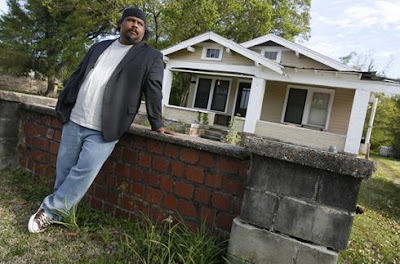 As we approach the 40th anniversary of Earth Day, it's a good time to reflect on the progress that has been made in the areas of environmental protection and sustainable development. However, we need to focus on the fact that environmental justice continues to elude poor communities throughout the nation. In fact, as the experience of Turkey Creek demonstrates, some environmental benefits may have actually come at their expense.
As we approach the 40th anniversary of Earth Day, it's a good time to reflect on the progress that has been made in the areas of environmental protection and sustainable development. However, we need to focus on the fact that environmental justice continues to elude poor communities throughout the nation. In fact, as the experience of Turkey Creek demonstrates, some environmental benefits may have actually come at their expense.
My good friend Leah Mahan has been working on a documentary about the Turkey Creek struggle for nine years. She began her project before Hurricane Katrina hit. Please check out her blog.(GW)For them, Earth Day was late in coming GULFPORT, Miss. — When freed slaves founded the community of
Turkey Creek in 1866, there was nothing here but swamps, oak trees and a muddy creek.
Through the years, sixth-generation resident Derrick Evans says, the area became a "dumping ground" for the kinds of hazardous or undesirable development no one wants to live next to: a sewage treatment facility, a chemical plant (which caught fire, leaked waste and closed), the city airport, and so on.
By 2005, many of the area's wetlands had been paved over, leaving Turkey Creek especially vulnerable to flooding when Hurricanes Katrina and Rita hit the Gulf Coast.
Evans, a community activist, says repeated appeals to local officials to halt harmful projects went unanswered. He says "things finally started going our way" when he realized that Turkey Creek was a haven for tropical birds, and he reached out to conservation groups such as the Audubon Society that he says had the legal resources to help.
"It's as if people cared more about birds than African Americans," Evans says. "It shouldn't have to be so hard."
Thursday is the 40th anniversary of the first Earth Day, which with the creation of the Environmental Protection Agency the same year, heralded the beginning of the modern environmental movement. The USA has seen environmental advancements during every decade since:
•1970s: Congress passed the Clean Water Act and Clean Air Act.
•1980s: The Superfund Law was passed, setting the stage for the cleanup of abandoned waste sites.
• 1990s: Amendments to the Clean Air Act brought more pollution protections from dust and soot.
• 2000s: Advances were made to cut vehicle and equipment emissions and to regulate mercury emissions.
Yet the head of the EPA under the Obama administration, Lisa Jackson, is among those who say the movement's achievements — including significantly cleaner air and water throughout much of the USA — have not been equally shared by low-income and minority communities such as Turkey Creek.
"We've come a long way" in 40 years, she says.
But she adds that the EPA, and environmentalists in general, need to do a better job of using the clout they've accumulated since 1970 to ensure more "environmental justice" — a term she and others use to describe the idea that everyone, no matter their race or income level, has the right to live in a healthy environment.
"This is part of the unfinished business of the environmental movement," Jackson says.
Numerous studies have shown that low-income and minority communities tend to suffer disproportionately from exposure to toxic substances and resulting health problems.
Robert Bullard, a professor at Clark Atlanta University whom Jackson describes as a pioneer of the environmental justice movement, says that blacks in particular "have been invisible to enforcement of environmental laws."
"Policymakers, most often white, decide that if something that causes environmental harm has to go somewhere, it will go in neighborhoods where decision-makers don't live," Bullard says.
"Years of segregation accentuated these differences."
Jackson was in North Charleston, S.C., Monday as part of a multi-state tour with members of the Congressional Black Caucus that aims to call attention to environmental justice issues and encourage local officials and activists to find solutions.
She visited a school in a largely minority community where the EPA is conducting air tests for toxic substances. (The testing program is the result of a 2008 USA TODAY investigation into toxic air at schools.) Future stops on the tour will include New York City, Atlanta and Oakland.
The first stop in January was in Jackson, Miss., where Jackson met Evans and learned about his community's ongoing struggles.
She calls Turkey Creek's case "emblematic" of similar problems she's trying to help address nationwide.
For Turkey Creek residents, their battle continues — this time over a new highway that Mississippi officials want to build through their watershed.
This time, Evans, 43, says he's ready for a fight.
"I've got my arsenal now," he says. "I've got the Sierra Club (an environmental group) right here. I've got the EPA over here. Which one do you want me to hit you with?"
'A fight over jobs'
Turkey Creek's founding the year after the Civil War ended predates Gulfport by more than 30 years. Over time, though, Gulfport grew — and it incorporated Turkey Creek in the 1990s.
Most of the community's 200 or so residents live much as they did a half-century ago along Rippy Road, a street bordered by towering oak trees.
Modern, ranch-style houses sit alongside some original, wood-frame structures — including the one that used to belong to "Grandma Benton," from whom most of the area's residents descended.
"We're all cousins here," says Evans' mother, the Rev. Lettie Evans-Caldwell, 75.
Just a few hundred feet away, though, the landscape changes to one of urban sprawl.
Gulfport's steady march north from the coast, which accelerated after Katrina and Rita ravaged the old city center, has been so pervasive that Evans says there are three Waffle Houses within five-sevenths of a mile of his house. "Nothing against hash browns," he says, "but that's ridiculous."
In 2001, despite loud protests from many residents, most of Turkey Creek's historic grave sites — including those of Grandma Benton's daughters — were paved over to create an apartment complex for low-income residents. By then, Evans and others were organizing to stop the construction of a multilane "connector road" for trucks between Gulfport's port and nearby Interstate 10, which would fill in another 162 acres of area wetlands.
"Rich, white folks would never have to put up with this," Evans says.
Gulfport Mayor George Schloegel says the road is necessary because the current expansion of the Panama Canal will create a dramatic increase in the city's seaport traffic. He says the expansion is "the biggest economic growth project in Mississippi's history" and says it will result in 15,000 new jobs.
"Don't let anybody tell you this is another sad story about race in Mississippi," Schloegel says. "This is a fight over jobs — jobs we need during this recession."
The race factor
Bullard, the environmental justice expert, says race has historically been "the most potent variable" in determining the location of hazardous sites.
"Income and education levels are less important ... determining factors," he says.
Bullard says the racial breach widened even further in recent years. He co-authored a 2007 study that said that, nationwide, 56% of Americans living within two miles of a commercial hazardous waste facility were people of color. That was up from 33% in a 1987 study, he says.
A separate 2008 study by University of Colorado sociologist Liam Downey found, based on U.S. Census data, that an average black household with an income of $50,000 to $60,000 a year coped with higher levels of pollution than an average white household with an income of less than $10,000.
Jackson says her tour is aimed at empowering local officials and grass-roots activists who can help reverse that trend — by stopping harmful development projects before they begin, or by starting or accelerating cleanup of polluted sites.
Rep. Bennie Thompson, a Democrat who hosted Jackson in Mississippi, says her visit has already resulted in greater accountability from regional and state officials, and "showed them that environmental justice is a priority for this EPA."
"It really matters who you've got at the top," he says.
Turkey Creek had a turning point of its own. During the period between President Obama's election in November 2008 and his inauguration 2½ months later, the EPA informed the Mississippi Department of Transportation (MDOT) that its plan to offset the environmental effects of the highway was insufficient, says department head Larry "Butch" Brown.
Determined to make the road project go ahead anyway, Brown convened a meeting of "all the relevant stakeholders in Turkey Creek" — among them Evans, the EPA, Mississippi's state environmental agency, and the powerful alliance of conservation groups that Evans had helped assemble.
"When you have a group of very vocal objectors, sometimes it's best to find an alternative," Brown says.
After a long day of negotiations, the agreed-upon solution was for the highway to go ahead. As a compromise, MDOT agreed to acquire more than 1,600 acres of land within the Turkey Creek watershed, much of it wetlands, and turn it over to the state's Department of Marine Resources.
The tract will be held in perpetuity by a local land trust — off limits to economic development "forever," Brown says.
Lessons learned
Evans says he's content with the deal.
"The road goes ahead, it's true, but that's a big piece of land that will never get built on," he says.
Mayor Schloegel says he's "furious," and announced last week that a legal challenge against MDOT is likely. "For God's sake, don't take that land off our tax rolls forever," Schloegel says.
Evans says the litigation threat means the battle isn't over. In the meantime, he has been freed up to concentrate on fixing years of damage to his community. He and other residents are working to label wild blueberry trees and other native vegetation that helped rally eco-tourists to his cause.
On a warm afternoon last week, four area teenagers were cruising down Turkey Creek in a motorboat, fishing for bass.
Evans called after them: "Hey, we're getting together some folks to clean out the creek, pull out some tires. Can you guys help?"
"Absolutely. I'll be there," said John Ryland, 18. He gave Evans his cellphone number and the boat puttered away.
"That's great, really great," Evans said after they had disappeared. "You get those kids, affluent kids, engaged at an early age, they'll take care of this place forever."
Recent victories aside, Evans doesn't see his story as one others should seek to repeat.
"This isn't a success story. Turkey Creek is a story of failure," Evans says. "This is a place that was forced by the failure of traditional environmentalism and government agencies to be incredibly creative to find a way to survive."
"It shouldn't have been necessary — but, hey, it was. Let it not be in vain. Let it be instructive."
(c) USA TODAY
 Buckminster Fuller defined Universe as "the aggregate of all humanity's consciously apprehended and communicated (to self or others) experiences." That's where he began all of his problem-solving thinking. It's the best way to ensure that you've considered all relevant considerations.
Buckminster Fuller defined Universe as "the aggregate of all humanity's consciously apprehended and communicated (to self or others) experiences." That's where he began all of his problem-solving thinking. It's the best way to ensure that you've considered all relevant considerations.











